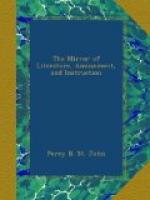The appearance of this town in the time of Leland is thus described by that celebrated writer:—“The town of Warwick hath been right strongly defended and waullid, having a compace of a good mile within the waul. The dike is most manifestly perceived from the castelle to the west gate, and there is a great crest of yearth that the waul stood on. Within the precincts of the toune is but one paroche chirche, dedicated to St. Mary, standing in the middle of the toune, faire and large. The toune standeth on a main rokki hill, rising from est to west. The beauty and glory of it is yn two streetes, whereof the hye street goes from est to west, having a righte goodely crosse in the middle of it, making a quadrivium, and goeth from north to south.” Its present name is derived, according to Matthew Paris, from Warmund, the father of Offa, king of the Mercians, who rebuilt it, and called it after his own name, Warwick.[3]
[3] “Inter Occidentalium
Anglorum Reges illustrissimos,
praecipua
commendationis laude celebratur, rex Warmundus,
ab his
qui
Historias Anglorum non solum relatu proferre,
sed etiam
scriptis
inserere, consueverant. Is fundator cujusdam urbis
a
seipso
denominatae; quae lingua Anglicana Warwick,
id est, Curia
Warmundi
nuncupatur.”—Matthaei Paris “Historia
Major,” a Watts,
edit.
1640.
The castle, which is one of the most magnificent specimens of the ancient baronial splendour of our ancestors now remaining in this kingdom, rears its proud and lofty turrets, gray with age, in the immediate vicinity of the town. It stands on a rocky eminence, forty feet in perpendicular height, and overhanging the river, which laves its base. The first fortified building on this spot was erected by the before-mentioned lady Ethelfleda, who built the donjon upon an artificial mound of earth. No part of that edifice, however, is now supposed to remain, except the mound, which is still to be traced in the western part of the grounds surrounding the castle. The present structure is evidently the work of different ages, the most ancient part being erected, as appears from the “Domesday Book,” in the reign of Edward the Confessor; which document also informs us, that it was “a special strong hold for the midland part of the kingdom.” In the reign of William the Norman it received considerable additions and improvements; when Turchill, the then vicomes of Warwick, was ordered by that monarch to enlarge and repair it. The Conqueror, however, being distrustful of Turchill, committed the custody of it to one of his own followers, Henry de Newburgh, whom he created Earl of Warwick, the first of that title of the Norman line. The stately building at the north-east angle, called Guy’s Tower, was erected in the year 1394, by Thomas Beauchamp, the son and successor of the first earl of that family, and was so called in honour of the ancient hero of that name, and also one of the earls of Warwick. It is 128 feet in height, and the walls, which are of solid masonry, measure 10 feet in thickness. Caesar’s Tower, which is supposed to be the most ancient part of the fabric, is 147 feet in height; but appears to be less lofty than that of Guy’s, from its being situated on a less elevated part of the rock.




